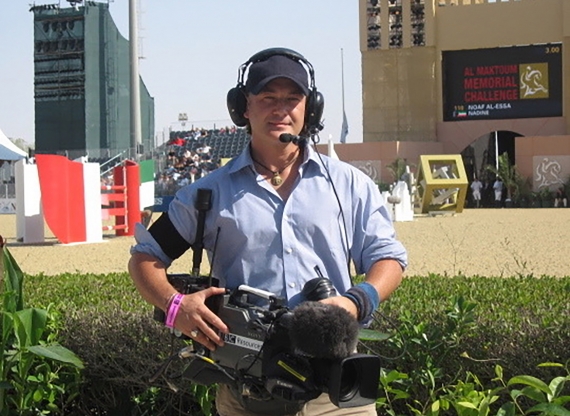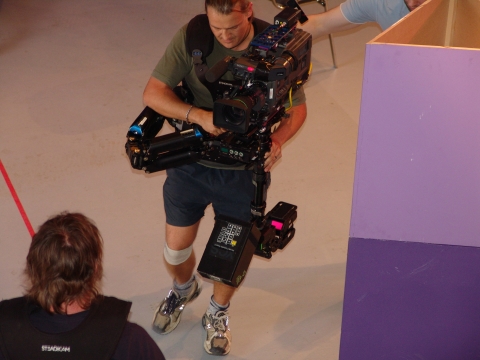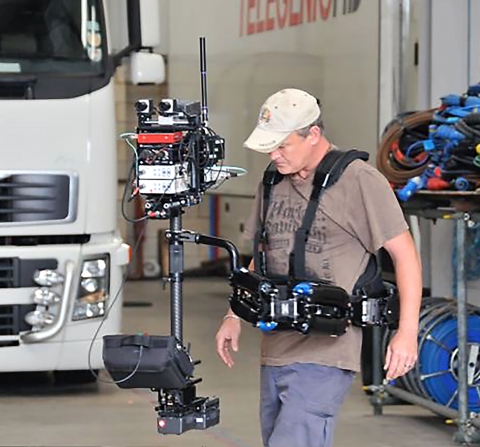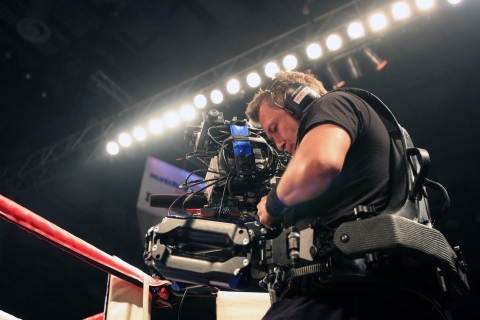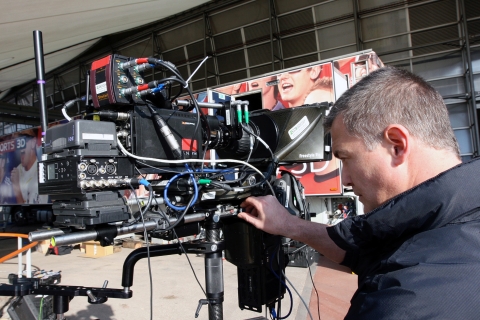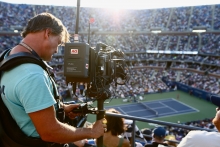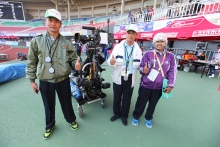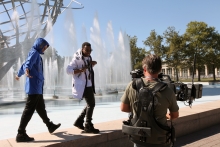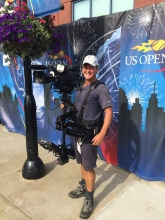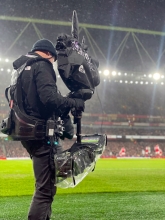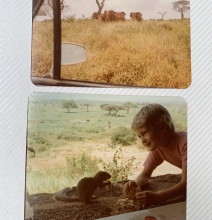Mike Murphy - CinemonitorUHD
Transvideo interview with Mike Murphy, Steadicam Operator
Show Jumping event in Dubai. 2004 I did a great deal of hand-held work earlier in my career. That experience served as a solid foundation to the transition into Steadicam.
Would you please start by explaining what your job is?
I work as a Steadicam owner/operator covering live events, mainly sport.
Over the years I have covered Athletics, Rugby, Boxing, Tennis, Cricket, Show Jumping, Motor Racing and of course Football.
Football is now, through choice, one of my main sources of work. I cover the EFL Championship and Premier League for the main UK Broadcasters but also the FIFA and UEFA Tournaments and CONCACAF tournaments in North America.
Do you have a website or IMDB page?
I don’t have an IMBD link because I work in the live outside broadcast sector and as such, technicians are not credited. I don’t have a website either because fortunately I don’t need one. I have worked with a hand full of clients my entire career to date and have been kept busy. One of the most honest, professional compliments ever paid to me was from a hard nosed, very successful, live sport tv director, whom I still work with, saying many years ago was..’Mike, I don’t care about your career..I want you on my jobs because you make me look good.'
When did you become a Steadicam operator, and how did you start?
I decided to specialise back in 2006, having gained by that stage, 12 years experience within the camera department. I loved hand-held camera work, so Steadicam seemed a logical progression.
We had sold our flat, so I had funds in place to invest in equipment. I took an Introduction to Steadicam course at the NFTS. I was busy every month with my existing camera operating work so there was no pressure to get out there and market myself as a Steadicam operator. Instead I got my head down and practiced at home using and old BetaSP camcorder, borrowed from a friend.
The global broadcast switch from analogue to HD was well under way. The Thomson and Sony camera bodies with RF units and the lens weighed approx 12kg’s. I attached small dumbbells to my practice camera, so to replicate a working weight. My first practice challenge was to achieve the ability to comfortably operate the rig for 45 minutes, effectively one half of a Football match. I gradually built my skill set and stamina but it was a slow process and I was a little concerned in the initial few months.
It was seven months in fact, after buying my initial rig, that I went out on my first Steadicam job. It was a 5 day booking. It went well because I was ready. That particular job extended to around 20 days per year and the run lasted eight years before the genre was eventually dropped by the broadcaster due to budgetary constraint decisions made at pay grade way higher than my own.
Steadicam workshop at the NFTS, instructed by Peter Cavacuiti and Peter Robertson. 2006 An intensive introductory course should be the first step for anybody hoping to make a career as a Steadicam operator.
When did you first become a Transvideo user?
It wasn’t until 2013, when I invested in a second rig that I bought my first Transvideo monitor. It was a CineMonitor 8 eSBL. I didn’t want to make duplicate purchases on more expensive gear until I had a solid grounding in the market and had gained, more relevantly, a better understanding of the supplier choices. Their products strengths and weaknesses and the ‘actual’ level of customer service and on site back up.
Other Steadicam operator's that I trusted and respected all used Transvideo as their choice of Steadicam monitor.
That first CineMonitor, serial number 14AS0020 performed faultlessly for 6 years before I traded it in with Transvideo using their part exchange option. At present I have the CineMonitorUHD8 X-SBL and the CineMonitorUHD8 eSBL, both units utilising identical mounting systems. I interchange them on a regular basis but essentially one acts as a back up to the other. If I were to encounter a monitor failure whilst on a job, which has never happened, it would take literally minutes to resolve the situation.
Going right back to your childhood, where did you grow up, and how was it?
I had a fairly nomadic childhood. I was born in Mauritius and grew up in Kenya in a leafy Nairobi suburb, called Karen. We also lived in Kisumu, on Lake Victoria and a small town at 2400m above sea level, called Iten, a remote place in the Western Highlands located on the escarpment of ‘The Great Rift Valley’. The area produces Kenya’s top flight long distance runners. My mum’s health was often poor and that taught me that life is a gift and to recognise the good times and appreciate simply being happy. Growing up in East Africa during the 1970’s and 80’s was an outdoor life granting so much freedom to get away and explore, I was always off either on my own, with my sister, my pals or with my family on safari trips, which we did regularly. Jean-Michel Jarre’s ‘Equinoxe’ and ‘Oxygene’ albums were always firm favourites among the dusty and cracked cassette cases crammed into all available door well spaces in the car.
Through my dad’s work as a consulting civil engineer, my sister, who was born in Kenya and I travelled a lot. We went to school for a year in Dubai in the late 70’s and even went to Iraq for our summer holidays in 1983. My teachers were amazed when I returned the following term, to hear that I had visited the ruins of Babylon, seen the great lion statue and stood at the point where the two great rivers, the Tigris and Euphrates join.
My parents were resolute to ensure that our senior school education was stable, which unfortunately meant boarding school in the UK. I actually really enjoyed it although the damp British weather was tough to get used to and still is so many years later!When I was 16 my dad went to work in Dharan, Eastern Nepal, geographically an interesting place nestling in the lush foothills of the Lower Himalayan Range. The altitude varies wildly with the areas southern tip sitting on the low laying Terai plains at only 350m above sea level toward the border with India. Whilst to the north the elevation reaches 4500m .. still not high by Himalayan standards but none the less an incredibly contrasting flora and fauna and related ecosystems.
I was really sad to leave Kenya (although I have returned many times) but over the following years through my A Levels and time at University I visited Nepal frequently both during the monsoon season in summer and the beautifully clear and crisp time between December and April.
I unfortunately experienced the earthquake on the 21st August, 1988. It was powerful, measuring 6.9 and struck in two instalments, just before dawn. In such remote parts of the world there is no official rescue effort in the immediate aftermath. My father and I went our separate ways to help the local people around us remove the rubble of their homes by hand, to free their trapped relatives. It was very tough emotionally witnessing such scenes first hand but I wasn’t injured and I hadn’t lost any of my family, whilst so many people around me had, so you just get on and do as much as you can to help. It’s easy to forget and in many cases never even realise, ‘eyes wide shut’, how privileged we are to live within the largely safe confines of Western Europe. Life is so cheap in most of the world and the poorest people endure the harshest blights.
Testing an RF 3D rig I developed with another engineer, Neil Shepherd. 2011 This lightweight system proved a successful alternative to the mainstream heavy duty rigs and was used extensively by UK broadcasters as part of their 3D spec covering Football, Rugby, Boxing and Golf.
Do you think anything in your childhood and teens contributed to your eventual career?
Yes absolutely, 100%. As a kid I used to watch my dad leave for work after breakfast in the morning and climb into his Peugeot 504 estate or Land Rover 110, dressed in shorts, smart collared short sleeved shirt, smelling of ‘Old Spice’ and always with a silver Parker ball point pen seated securely in the breast pocket and sporting a pair of safari boots, combined with rather unflattering tan socks!.. I too wanted to go to work, if the sun was shining in a pair of shorts and t shirt and I wanted to see more of the world, no tan socks or ‘Old Spice’ though.
I really enjoyed occasionally going out with my dad, during the school holidays, throughout my childhood and teen years to see his road and bridge projects and meet / catch up with all the varied characters he worked with.
Once when I was 15, going on a four day road trip in the back of a flat bed Land Rover with two of my dad’s trusted foremen to visit a project right up in the northern desert territory of Turkana, I realised that I didn’t want to be a civil engineer, and I also knew that I would never sit behind a desk, in an office.
What was the first thing you did that could be considered as leading to your eventual career?
My light bulb moment came during my second year at University in London in 1992. There were practical video production modules which formed part of the media degree course. Students were split into small groups and were required to produce a short film or documentary by the end of the semester. A member of our group was heavily involved with animal rights and the anti fox hunting lobby in particular. She was so passionate and knowledgeable on the subject and more importantly, was part of and had excellent contacts within the tightly knit, UK fox hunt saboteur community. It seemed, as the saying goes, a ‘no brainer’ between our group, that we should make a documentary based on this subject matter. I put my hand up to ‘play the role’ of camera operator. The morning of our first shoot we were instructed to wait for a battered old Transit van that picked us up from a busy junction in south east London..It was 4.30 on a Saturday morning and I was more concerned about getting mugged as I stood waiting with the gear. The first stop the van made was at a services on the A20. It was a pre arranged meeting place for the saboteur group, which on that morning comprised about 20 individuals. They appeared well organised and would be divided into smaller groups, communicating via radio comms. We would be heading into the Kent countryside to disrupt a large established hunt. During the course of that day I knew I was hooked, not on the subject matter but on the job of a ‘cameraman’. At one point early on in the day I was charged at by a huntsman on his horse, he veered away at the last moment of course, his booted stirrup kicking out at me. I had managed to capture the scene on VHS, albeit quite shaky and out of focus! The saddest and most shocking incident came later in the afternoon when we managed to film from a distance, a group of ‘Terrier boys’ as they were known, digging a fox out with shovels, after it had gone to ground and throwing the terrified animal to the crying hounds. We later copied the footage and handed it to the police. That single day was the catalyst that set in place the career path I wanted to take. From that point onward my goal was to make it happen and I understood that it was going to take a great deal of patience and application to develop the necessary craft skills.
3D HD mini RF camera rig, ring side boxing coverage. 2011 The extensive prep work paid off as the system integrated seamlessly into the OB's multi camera work flow.
What was the first paying job associated with your career? Did you enjoy it? Was at this point that you decided on your career path?
After I left Uni in 93’ I moved down to Brighton, on the south coast of England. Living in a party town like Brighton, in the mid 90’s was a lot of fun! I worked as an office temp during the day and worked two different bar jobs in the evenings, so as I could start paying off my student loans. I didn’t want to defer the re payments, even with minimal interest. I wanted the student debt gone, so as I could get into more real life debt! During this period, before I landed my first and only staff job in telly, I also worked as a freelance runner and trainee camera assistant, with two established Brighton based production companies. Shoot days were long, always in excess of 12 hours. I felt more like a ‘gopher’ ..go for this, go for that but I knew it was a valuable part of my education and I knew what I wanted to do. I had decided that I wanted to be a camera operator during my time at university and these experiences where just that, experiences that form part of the individuals story and stepping stones on the overall journey. What I did know back then was that I would never look back as an old man and think ‘I wish I had done that’ .
An older colleague and friend said to me years ago ‘There are two types of people working in film and television..Those that are trying to get in and those that are trying to get out!’ it made me laugh then as it does now. Thankfully, I don’t fall into the latter category of that statement yet. As the saying goes ’ Love what you do and never work a day in your life’.
Balancing the P + S Technik Freestyle rig and steadicam sled. 2011 By reversing the Steadicam sleds top stage by 180 degrees, the Freestyle rig balanced quite well but it was heavy, weighing in excess of 30kg’s.
Having reached where you are now in your career, is there anything you haven’t yet done yet that you would like to do?
I am very happy where I am now. Things can and do change in an instant and as a successful freelancer in any department, you need to be able to adapt and often quickly.. Mike Tyson said, prior to his famous clash with Evander Holyfield ‘Everybody has a plan..until they get punched in the mouth.’ Harsh as that sounds, in a non aggressive, metaphorical sense, it is a true and accurate take on life.
I am very lucky to work in live TV and sport. My work as a Steadicam operator has literally taken me all over the world. As and when that changes, I will stay light on my feet and evolve, it is the circle of life.
Is there anyone you would like to thank for helping you along the way?
Back in the day, my parents for showing me what life is really about and for ensuring their kids received a solid education.
As far as who I am as a professional? I provide a service along side many other equally skilled men and women. I give 110% every day I leave the house to go to work. One of the things I really love about in this industry is the sheer melting pot of personalities, from all walks of life, that are drawn together to get a job done and done well. I think that ‘helping along the way’ is a two way street which starts with plain and simple camaraderie and mutual respect. The individuals I would like to thank know who they are because they have always had my loyalty. I would certainly like to also thank my small number of fantastic kit suppliers: Transvideo, GPI Pro, Walter Klassen and Optical Support for their market leading products, their exemplary customer care and specialist advice, always delivered promptly.
Corona Park. Queens. NYC. 2013 Two young rap artists were using the Unisphere at Flushing Meadows as a backdrop for their music video. I too was shooting GV’s for our show. We got talking and I simply attached their little DSLR to the top of my lens hood, rebalanced the rig and bingo they had Steadicam shots. No money changed hands, it was just a really fun few minutes and their music video looked great.
Working in the rain. 2023 The kit is fully protected. The CineMonitorUHD8 X-SBL, as with all the Transvideo CineMonitor range benefits from military grade optically bonded glass. I quite often remove the perspex screen protector from the monitor rain cover because I am fully confident that water ingress will not be an issue.

